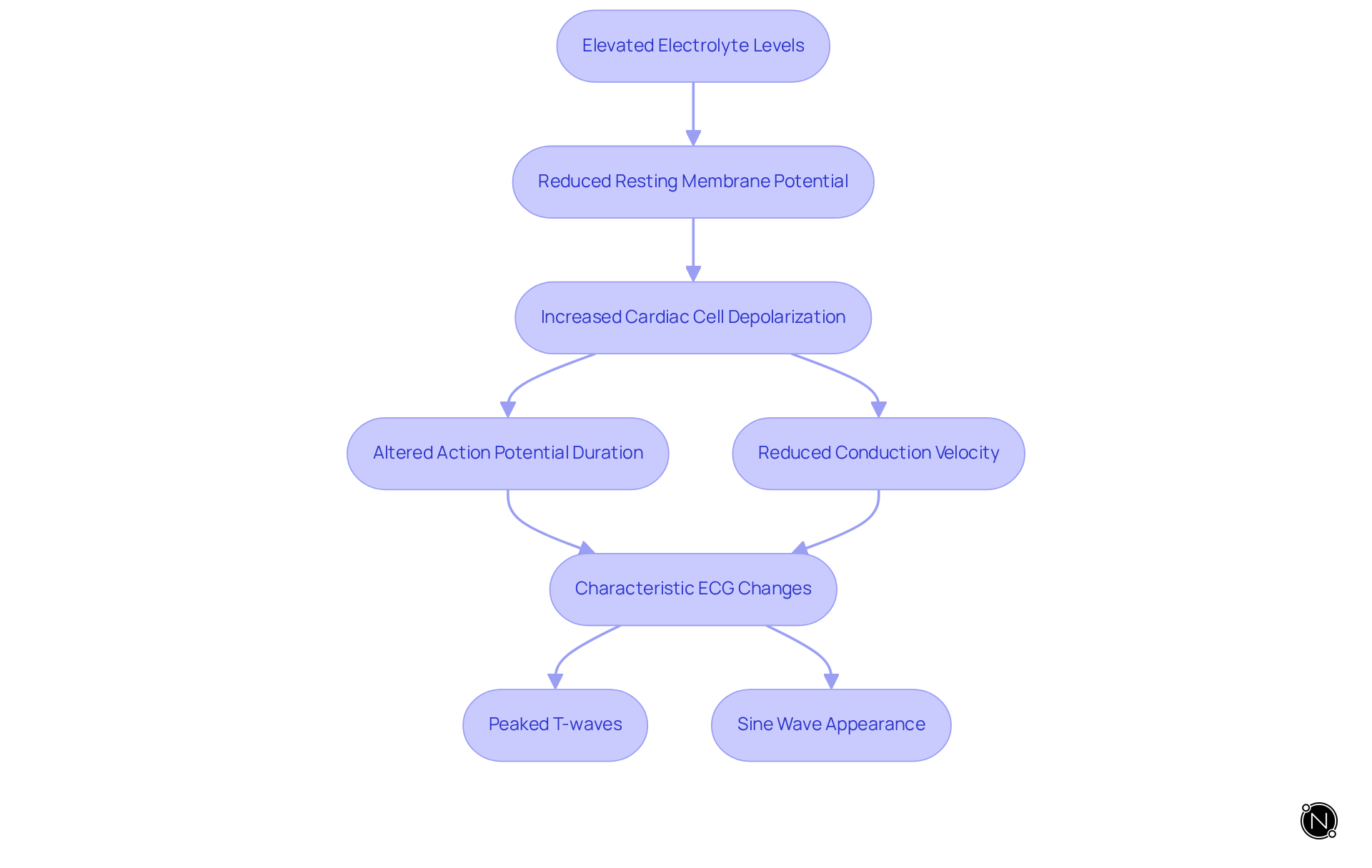Overview
The article provides an overview of the ECG changes linked to hyperkalemia and outlines effective management strategies for this condition. It details how hyperkalemia can result in significant ECG alterations, such as peaked T-waves and prolonged QRS complexes, which signal critical cardiac risks. The article underscores the necessity of prompt intervention through treatments like calcium administration and continuous ECG monitoring to avert life-threatening complications.
Introduction
Hyperkalemia is a condition characterized by elevated potassium levels in the bloodstream, which poses serious risks to cardiac health and can lead to life-threatening arrhythmias. Understanding the ECG changes associated with hyperkalemia is essential for healthcare professionals, as these alterations serve as critical indicators for timely intervention.
The challenge remains for clinicians: how can they effectively recognize and manage these ECG changes to prevent severe complications?
This article explores the complexities of hyperkalemia, its clinical significance, the pathophysiological mechanisms behind ECG alterations, and comprehensive management strategies aimed at safeguarding patient health.
Define Hyperkalaemia and Its Clinical Relevance
Hyperkalemia is characterized by elevated electrolyte levels in the bloodstream, typically exceeding 5.0 mEq/L. This condition is clinically significant because potassium is essential for maintaining normal cardiac electrical activity. When potassium levels rise, they can disrupt the heart's electrical conduction system, leading to potentially life-threatening arrhythmias.
For instance, in-hospital death rates can exceed 15% when potassium levels surpass 5.5 mmol/L, with severe cases resulting in a 3.0-fold increase in mortality risk, and rates can reach as high as 18.1% for individuals with elevated potassium levels.
Common causes of elevated potassium include:
- Kidney failure
- Excessive dietary intake
- Certain medications, particularly those that retain potassium
Clinicians must remain vigilant in monitoring potassium levels, especially in patients with pre-existing kidney conditions, as prompt intervention can avert serious complications such as cardiac arrest.
The impact of high potassium levels on cardiac health is significant; studies show that both low and high potassium levels markedly increase the risk of all-cause and cardiovascular mortality. Notable hyperkalemia ECG changes include decreased or 'flattened' P waves and prolonged QRS complexes. Therefore, implementing effective management strategies is crucial to mitigate these risks and ensure patient safety.

Identify ECG Changes Induced by Hyperkalaemia
Hyperkalaemia ECG alterations progress through distinct stages as electrolyte levels rise. Initially, peaked T-waves are often observed on a hyperkalaemia ECG, serving as the primary indication of elevated levels of potassium. As hyperkalaemia ECG worsens, the PR interval may lengthen, and the QRS complex can widen, indicating conduction delays. In severe instances, the QRS may merge with the T-wave, forming a sine-wave pattern, which is indicative of a hyperkalaemia ECG and can precede ventricular fibrillation. Recognizing these changes in the hyperkalaemia ECG is critical for healthcare providers, as they may indicate an urgent need for intervention to prevent serious cardiac events.
Recent studies reveal that peaked T-waves are common in patients with hyperkalaemia as shown in the ECG. Findings suggest that patients treated with sodium zirconium cyclosilicate (SZC) were 77% less likely to require emergency hemodialysis. This highlights the necessity for clinicians to remain vigilant in monitoring these alterations. The continuous learning model of advanced ECG analysis platforms, such as MaxYield™, significantly enhances the detection of these crucial changes, facilitating timely and informed clinical decisions.
MaxYield™ offers several features that improve ECG analysis:
- Its advanced algorithms allow for real-time monitoring of ECG changes, providing healthcare professionals with immediate insights.
- Additionally, the platform integrates seamlessly with existing healthcare systems, ensuring that clinicians can access vital information without disruption.
- The benefits of using MaxYield™ include improved patient outcomes through timely interventions and reduced reliance on emergency procedures.
As William R. Marshall notes, 'SZC presents clinicians with a conservative treatment option that is efficacious and has a favourable safety profile,' which reinforces the importance of precise monitoring of hyperkalaemia ECG in managing the condition. By leveraging platforms like MaxYield™, healthcare providers can enhance their ECG analysis capabilities, ultimately leading to better patient care.

Explain the Pathophysiology Behind ECG Changes
The pathophysiology of ECG alterations due to high mineral concentrations is closely related to the effects of elevated electrolyte levels on cardiac myocyte excitability and conduction. Increased extracellular ion concentrations lead to a reduction in the resting membrane potential, which promotes the depolarization of cardiac cells. This change significantly affects the action potential duration and conduction velocity, resulting in characteristic ECG manifestations.
As the concentration of the mineral increases, the gradient for its efflux during repolarization diminishes, leading to peaked T-waves, a hallmark of elevated levels. Research indicates that severe potassium elevation, defined as potassium levels ≥ 7.0 mmol/L, can result in a sine-wave appearance on the hyperkalaemia ECG, complicating both diagnosis and management.
Clinicians must remain vigilant, as even individuals with normal ECGs can experience sudden cardiac arrest due to elevated potassium levels. This underscores the critical need for accurate ECG interpretation in emergency situations.
A notable case involved a patient with severely elevated potassium levels (K+ 9.0 mEq/L) secondary to rhabdomyolysis, who presented with pronounced peaked T waves and a sine wave appearance on the hyperkalaemia ECG. This case highlights the importance of recognizing early ECG changes to facilitate timely intervention.

Outline Management Strategies for Hyperkalaemia
Effective management of hyperkalaemia ECG requires a multifaceted approach to lower serum mineral levels and stabilize cardiac function. Initial treatment typically involves administering calcium gluconate or calcium chloride, which are crucial for protecting the myocardium from the detrimental effects of elevated potassium levels. For a rapid decrease in potassium, insulin combined with glucose is commonly used to facilitate its intracellular shift, while beta-agonists can further amplify this effect. In severe cases, dialysis may be necessary to remove excess potassium from the bloodstream.
Addressing the underlying causes of elevated potassium levels, such as medication adjustments or treatment for renal failure, is vital for long-term management. Continuous ECG monitoring during treatment is essential to ensure safety and effectively resolve elevated potassium levels. Recent alerts, including the National Patient Safety Alert, have underscored the importance of proper calcium gluconate administration, as dosing errors can lead to serious complications, including fatalities. For instance, an analysis of safety occurrences revealed 31 cases categorized as fatal and 25 as serious harm associated with calcium salts, emphasizing the need for heightened awareness among healthcare providers regarding the urgent nature of managing severe hyperkalemia.
Healthcare professionals stress that immediate intravenous administration of calcium-based salts is the standard of care for ECG changes associated with hyperkalaemia. The Adult Renal Association Clinical Practice Guidelines recommend a complete 30ml dose of calcium gluconate to initiate treatment effectively. Additionally, research indicates that potassium monitoring can significantly reduce the incidence of severe hyperkalemia-related adverse events, particularly in patients receiving RAAS inhibitors. Therefore, implementing standardized protocols for calcium gluconate administration, including laminated treatment protocols in clinical settings, and ensuring continuous monitoring can substantially improve patient outcomes in hyperkalemia management.

Conclusion
Hyperkalemia represents a critical clinical condition characterized by elevated potassium levels that pose significant risks to cardiac health. Understanding its ECG changes and implementing effective management strategies are essential for safeguarding patient safety. As potassium levels rise, the heart's electrical conduction can be severely disrupted, leading to dangerous arrhythmias and increased mortality rates.
The article outlines key aspects of hyperkalemia, including its definition, the ECG changes associated with it, and the underlying pathophysiology. It highlights the importance of recognizing early ECG alterations, such as:
- Peaked T-waves
- Prolonged QRS complexes
These indicators can prompt timely interventions. Furthermore, effective management strategies, including the administration of calcium gluconate and continuous ECG monitoring, are crucial in addressing elevated potassium levels and preventing severe complications.
In light of the significant implications of hyperkalemia on cardiac health, healthcare professionals must prioritize vigilant monitoring and adherence to established management protocols. By leveraging advanced ECG analysis tools and remaining aware of the potential risks, clinicians can enhance patient outcomes and mitigate the dangers associated with hyperkalemia. Emphasizing the importance of education and continuous learning in this area is vital, as it fosters a proactive approach to managing this potentially life-threatening condition.
Frequently Asked Questions
What is hyperkalemia?
Hyperkalemia is a condition characterized by elevated potassium levels in the bloodstream, typically exceeding 5.0 mEq/L.
Why is hyperkalemia clinically significant?
Hyperkalemia is clinically significant because potassium is essential for maintaining normal cardiac electrical activity. Elevated potassium levels can disrupt the heart's electrical conduction system, leading to potentially life-threatening arrhythmias.
What are the risks associated with elevated potassium levels?
Elevated potassium levels can lead to increased mortality risk, with in-hospital death rates exceeding 15% when potassium levels surpass 5.5 mmol/L. Severe cases can result in a 3.0-fold increase in mortality risk, with rates reaching as high as 18.1% for individuals with elevated potassium levels.
What are common causes of hyperkalemia?
Common causes of hyperkalemia include kidney failure, excessive dietary intake of potassium, and certain medications that retain potassium.
Who should be monitored for hyperkalemia?
Clinicians must monitor potassium levels in patients with pre-existing kidney conditions, as prompt intervention can prevent serious complications such as cardiac arrest.
How does hyperkalemia affect cardiac health?
High potassium levels significantly increase the risk of all-cause and cardiovascular mortality. Notable ECG changes associated with hyperkalemia include decreased or 'flattened' P waves and prolonged QRS complexes.
What is the importance of managing hyperkalemia?
Implementing effective management strategies for hyperkalemia is crucial to mitigate risks and ensure patient safety.






